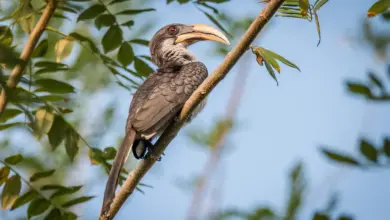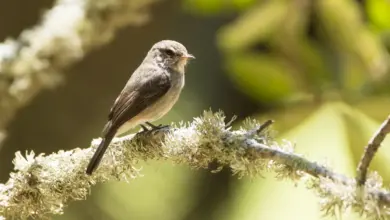Ferruginous Hawks (Buteo regalis)
The Ferruginous Hawks, Buteo regalis, is a large buzzard-type hawk.
Adults have long broad wings and a broad grey, rusty or white tail. The legs are feathered to the talons, like the Rough-legged Hawk.
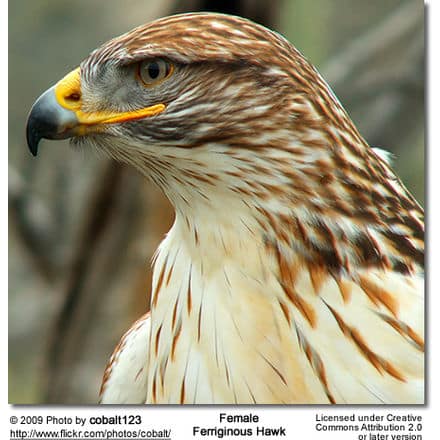
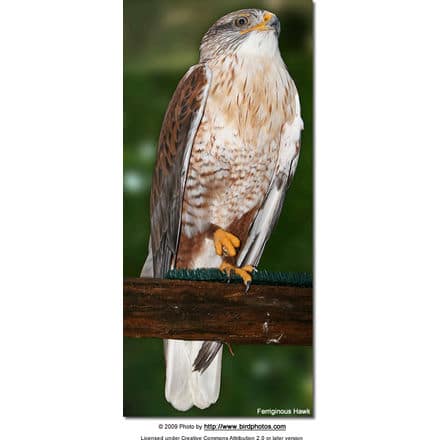
There are two colour forms:
- Light morph birds are rusty brown on the upper parts and pale on the head, neck and underparts with rust on the legs and some rust marking on the underwing. The upper wings are grey.
- Dark morph birds are dark brown on both upperparts and underparts with light areas on the upper and lower wings.
Their breeding habitat is prairie and open country in mid-western North America. They build a stick nest on top of a tree or cliff edge, sometimes on the ground.
Sometimes, cattle dung is used to line nest; historically, buffalo dung was used. In the central part of their range, they are permanent residents. Northern birds migrate to the southern United States and Mexico.
These birds search for prey while flying over open country or from a perch. They may also wait in ambush outside the prey’s burrow. They mainly eat small or medium-sized mammals such as jackrabbits and ground squirrels, also snakes and large insects.
Studies have found that prairie dogs can be a main prey item for Ferruginous Hawks, linking them to the populations of prairie dog towns in the mid-west and southwestern United States, which have been declining in recent years.
“Ferruginous” refers to the rusty color of the light morph birds.
This bird’s numbers are declining due to loss of habitat. This bird may also be sensitive to the use of pesticides on farms; they are also frequently shot.

Description
The ferruginous hawks is a large, long-winged buteo of the open, arid grasslands and shrub steppe country of the interior parts of North America.
Although flexible in choosing a nest site and exhibiting a high reproductive potential, this bird’s restriction to natural grasslands on the breeding grounds and specialized predation on mammals persecuted on rangelands may make conservation a continuous concern.
It is migratory in the northern parts of its range but can be found year round in the mid and southwest United States.
At times it has been considered threatened, endangered, or of concern on various threatened species lists but recent population increases in local areas, coupled with conservation initiatives, have created some optimism about the bird’s future.
This is the largest of the buteos and is often mistaken for an eagle due to its size, proportions and behavior. As with all raptors the female is larger than the male, but there is some overlap in the range of measurements for both.
Length measurements range from 20 to 26 inches (51 to 66 cm) with an average of 23 inches (58 cm); wingspans from 48 to 60 inches (122 to 152 cm) with an average of 56 inches (142 cm); and weights from 2.2 to 4.5 pounds (998 to 2,041 g).
Classification
There has recently been an opinion that because of DNA studies the Ferruginous Hawk should be reclassified as an eagle.
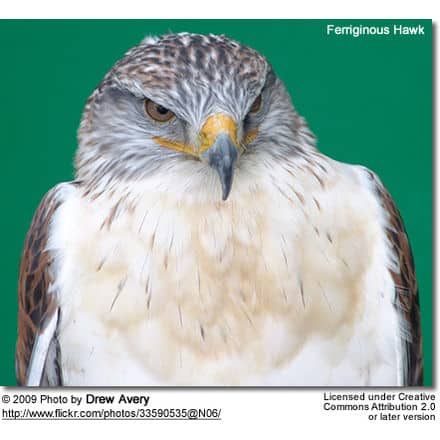
Identification Tips
The male and female have identical markings. The main difference is size, with the female being larger. Perched birds have a white breast and body with dark legs. The back and wings are a brownish rust color. The head is white with a dark streak extending behind the eye. The wing tips almost reach the tip of the tail.
The underside is primarily light colored with the dark legs forming a “V” shape. This is a large hawk with a reddish upper back and inner wing-coverts or “shoulders” (please refer to Wing Anatomy).
The primaries (= longest wing feathers) are dark gray with conspicuous light “windows” in the inner primaries (longest wing feathers). Three prominent light areas on the upper surface stand out as two “windows” on the outer wings and a rufous rump mark.
The underwings are whitish overall with rufous markings, particularly in the patagial area. This gives a smudgy appearance to the wings but less dark than a red-tailed hawk. Dark “comma” shaped markings are prominent at the wrists.
Habitat
The preferred habitat for ferruginous hawks is the arid, semiarid and grassland regions of North America. The countryside is open, level, or rolling prairies; foothills or middle elevation plateaus largely devoid of trees; and cultivated shelterbelts or riparian corridors.
Rock outcrops, shallow canyons, and gullies may characterize some habitats. These hawks avoid high elevations, forest interiors, narrow canyons, and cliff areas.
During the breeding season, the preference is for grasslands, sage, and other arid shrub country. Nesting occurs in the open areas or in trees including cottonwoods, willows, and swamp oaks along waterways.
Cultivated fields and modified grasslands are avoided during the breeding period. The density of ferruginous hawks in grasslands declines in a direct, inverse relationship to the degree of cultivation of the grasslands.
However, high densities have been reported in areas where nearly 80 percent of the grassland was under cultivation.
The winter habitat is similar to that used during the summer. However, cultivated areas are not necessarily avoided, particularly when the crops are not ploughed under after harvest.
The standing stubble provides habitat for the small mammal prey base needed by ferruginous and other hawks. Some key attributes of the habitat include the availability of perches such as poles, lone trees, knolls, rocky outcrops or large boulders.
Nesting will occur in trees if they are available, including riparian strips but the presence of water does not appear to be critical to ferruginous hawks.
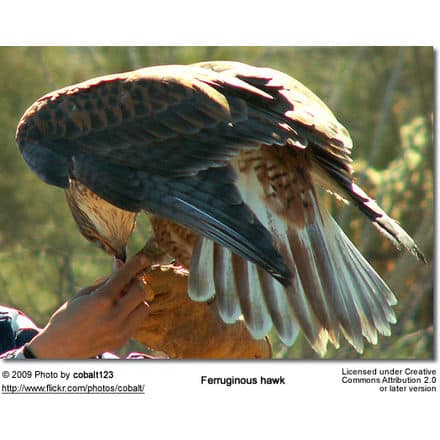
Range
The ferruginous hawk breeds from southeastern Alberta, southern Saskatchewan and extreme southwestern Manitoba south through eastern Washington, eastern Oregon, and Nevada to Arizona and New Mexico.
Its breeding range extends eastward to include Utah, Colorado, Wyoming, Idaho, Montana, the Dakotas and small parts of western Nebraska, Oklahoma and Texas. As such, it has the smallest breeding range of any buteo occurring regularly north of Mexico.
The wintering range includes the breeding range north only to the latitudes of northern Wyoming, but it expands west in Oregon and includes California, south into Mexico and eastward in South Dakota, Nebraska, Kansas, Oklahoma and Texas. Year-round, the ferruginous hawk can be found within the breeding range except for the Canadian provinces, Washington, northern Oregon, Montana, North Dakota and northern South Dakota and northern Wyoming.
Stragglers in migration and winter have occurred in Ohio, Tennessee, Virginia, New Jersey, Minnesota, Wisconsin, and Florida. There are no subspecies and this species occurs nowhere in the world except in North America.
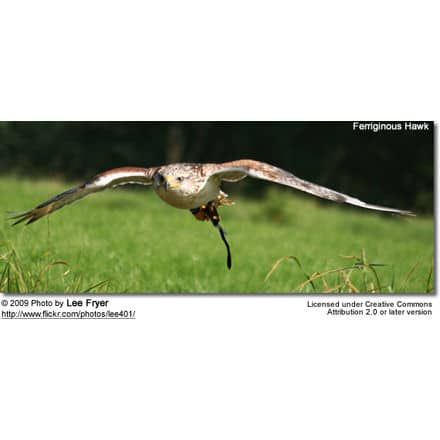
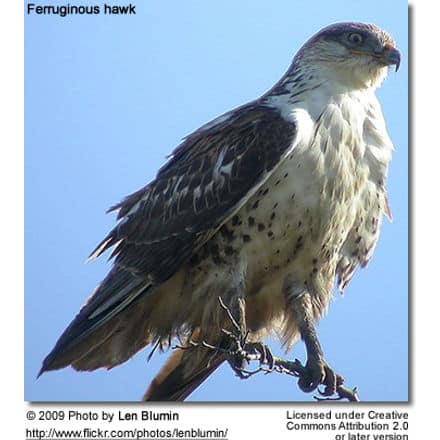
Behavior
The flight of the ferruginous hawk is active, with slow wing beats much like that of a small eagle. Soaring with the wings held in a strong dihedral has been noted, as well as gliding with the wings held flat, or in a modified dihedral. Hovering and low cruising over the ground are also used as hunting techniques. The wing beat has been described as “fluid” by some observers.
Hunting may occur at any time of the day depending upon the activity patterns of the major prey species. A bimodal pattern of early morning and late afternoon hunting may be common. The hunting tactics can be grouped into seven basic strategies:
- Perch and Wait – perching is on any elevated natural or man-made site
- Ground Perching – the hawk will stand on the ground at a rodent burrow after initially locating it from the air. As the burrowing animal reaches the surface, the hawk rises into the air and pounces upon it even while it is still underneath the loose earth.
- Low-level Flight – birds will course over the landscape within a few yards of the ground and pursue in direct, low level chases, or they will hunt from 40 to 60 feet (12.4 to 18.6 m) above the ground.
- High-level Flight – birds will hunt while soaring, but the success rate is generally low.
- Hovering – using quickened wing beats, often in times of increased winds, the birds will search the ground and drop on the prey.
- Cooperative Hunting – mates have been known to assist each other.
- Piracy – the ferruginous hawk has been observed gathering around a hunter shooting prairie dogs, and to claim shot “dogs” by flying to them and mantling over them.
In the strike, kill, and consumption type of predation, the victims are seized with the feet and a series of blows may be meted out, including driving the rear talon into the body to puncture vital organs.
Biting with the beak may also take place. Before bringing prey to the nest, the adults will often eat the head. At the nest, birds are plucked and mammals torn into pieces before being fed to the young.
Food caching has been noted, but not generally near the nest.
The ferruginous hawk maintains minimum distances from other nesting raptors but will nest closer than necessary, suggesting that the distance is not fixed. The “nearest neighbor” distance has varied from less than 1 mile (1.6 km) to as much as 4 miles (6.4 km) with an average of 2 miles (3.2 km).
Nests facing different hunting territories are tolerated much closer than nests facing the same hunting territory. The minimum distance between nests is probably about one half mile on densely-occupied areas.
Territorial conflicts have been reported with other species, such as the great horned and short-eared owl, Northern harrier, red-tailed and Swainson’s hawk, golden eagle, accipiters, ravens, and magpies. It seems to be quite tolerant of other ferruginous hawks from adjacent territories.
Nesting densities in several studies have varied from one pair per four to 2,450 square miles (10.4 to 6,346 square km). In Alberta, on one study site, there was a stable density of one pair per four square miles (10.4 square km), on average with little deviation from this mean. In Idaho, the average home range for four pairs of ferruginous hawks in the Snake River area was slightly over two square miles (5.2 square km).

Nesting
The ferruginous hawk is one of the most adaptable nesters of all of the raptors, and will use trees, ledges, rock or dirt outcrops, the ground, haystacks, nest platforms, power poles, and other man-made structures.
Within some broad categories such as cliffs, the variety includes clay, dirt and rock substrates. Tree nests are typically in isolated trees or isolated clumps of trees in exposed locations.
Authors differ as to whether ground nests are more successful than tree nests, but they are more susceptible to mammalian predation. Nest locations are reused frequently, but several nests may be built in an area.
Typically, one or two alternate nests may exist but up to eight have been found on some territories.
The nests are made of ground debris such as sticks, branches, and cattails. Old nests will be refurbished, or nests of other species may be taken over and refurbished with sticks being added on top of the old nests.
Odd items such as paper, rubbish, barbed wire, cornstalks, plastic and steel cable have been incorporated into nests. Bark from trees and shrubs will be used for lining along with grasses and cow dung.
Bits and pieces of greenery are often added to the nest. Both sexes are involved with building the nests and bringing materials, but the male seems to be more involved in retrieving materials while the female arranges them in the structure.
Food/Diet
The ferruginous hawk primarily hunts small to medium-sized mammals but will also take birds, reptiles, and some insects. Mammals generally comprise 80 to 90 percent of the prey items or biomass in the diet with birds being the next most common component.
The diet varies somewhat geographically, depending upon the distribution of certain prey species, but where the range of the ferruginous hawks overlaps, the black-tailed jackrabbit is a major food species along with ground squirrels and pocket gophers.
Depending upon the relative abundance of jackrabbits and ground squirrels, the latter could become the major food source. The particular species is dependent upon its occurrence within the range of the hawk.
Prey
The species taken by ferruginous hawks depends on range overlap and subsequent availability. Common prey items include rodents, birds, reptiles and insects.
Voice
The voice is not well-described in literature. Alarm calls consist of “kree – a” or “ke – ah” and harsh “kaah, kaah” calls. The latter resembling some vocalizations of the herring gull. One description referred to the “wavering” alarm call and “breathy” notes while other authors describe screams similar to those of the red-tailed hawk.
Reproduction/Life Span
Copulation occurs during and after nest building. The egg-laying period varies with latitude, weather, and possibly food supply. In the Canadian parts of the range, laying occurs during the latter part of April through late June, whereas farther south laying starts from about March 20 through mid May.
The earliest recorded clutch was in January in Utah and laying could occur as late as July 3 in Canada. Egg-laying occurs at two-day intervals with incubation starting when the first egg is laid.
Incubation is shared by both sexes with each taking approximately the same number of shifts during the 32 day average incubation period. Replacement clutches following failure appears to be rare.
Courtship flights seem to be limited in the accepted sense. Both sexes engage in high, circling flight but literature details are sketchy.
Soaring activities may primarily be variations on territorial defense flights as opposed to courtship per se. The “flutter – glide” flight consists of a series of shallow, rapid wing beats interspersed with brief glides and may serve to advertise the territory.
The “sky-dance” is stimulated by an intruder and consists of slow flight with deep, labored wing beats with irregular yawing and pitching that may terminate in steep dives. In the “follow-soar” maneuver, the male ferruginous hawks will fly below an intruder and escort it out of the territory.
High perching occurs from prominent places around the nest, particularly early in the breeding cycle. Aggressive actions such as attacking, talon-grasping, and pursuit have been noted by some observers.
Copulation begins before construction of the new nest, and increases in frequency until the start of egg laying. The passing of food may occur before the activity. The duration of copulation is from four to 18 seconds.
Clutch size varies from one to eight and is likely linked to food supply. The average clutch is three to four eggs, each 2.5 inches (6.35 cm) long and 2 inches (5.08 cm) wide.
They are smooth, non-glossy and whitish in color, irregularly spotted or speckled and blotched with reddish – brown markings. There may be a concentration of darker pigments at the small end of the egg.
Occasionally, the eggs are almost unmarked or have faint scribblings on them.
The nestling period varies from 38 to 50 days with brooding primarily by the female. Males fledge at 38 to 40 days and the females as late as 50 days after hatching, or 10 days later than their male siblings as they take longer to develop.
Nestlings lie or sit for the first two weeks, stand at about three weeks and walk soon after. By 16 or 18 days, they are able to feed on their own.
Wing flapping starts about day 23 and by day 33 the young are capable of vigorous flapping and “flap jumps.” The nestlings are sensitive to high temperatures and seek shade however possible in the nest.
Initial movement out of the nest is felt to be a response to heat stress as the young quickly move towards shade. The initial flight for the males is taken at 38 to 40 days while the slower-developing females fly about 10 days later.
Post-fledging dependency upon the parents may last for several weeks. During the first four weeks after fledging, the young patrol increasingly large areas around the nest as they learn to hunt. Young hawks have killed prey as early as four days after fledging.
The ferruginous hawks is single-brooded and like so many raptors, the number of young reared is tied closely to food supply. In areas where jackrabbit populations are the principal food source, the initial clutch sizes and the number of reared young vary closely with variations in the number of jackrabbits.
Fifty percent loss of young has been reported in low jackrabbit years. Fledging rates of 2.7 to 3.6 young per nest have been reported during years of abundant food supply. The high potential clutch size allows for a quick response to increases in the prey base.
Birds have been known to live for 20 years in the wild, but most birds probably die within the first five years. The oldest banded birds were recovered at age 20.
First year mortality has been estimated at 66 percent and the adult mortality at 25 percent. The reasons for mortality include illegal shooting, loss of a satisfactory food supply, harassment, predation, and starvation of nestlings during times of low food supply.
Ground nests are susceptible to predation by coyotes, and nestlings may be preyed upon by great horned owls and golden eagles.
Conservation
The ferruginous hawks was on the National Audubon Society’s “Blue List” of species felt to be declining. From 1971 to 1981 it retained its “blue” status, and from 1982 to 1986 it was listed as a species of “Special Concern.”
The United States Fish and Wildlife Service placed it in a category of “undetermined” in 1973, and various states have placed it in categories of “Threatened” or “Endangered.” In Canada, the Committee on the Status of Endangered Wildlife in Canada considered this species “Threatened” in 1980.
Across the Canadian prairies, the range was diminishing up until 1980, and at that time, birds were felt to be occupying 48 percent of its original range. Numbers were generally felt to be diminishing and a total Canadian population was estimated at 500 to 1000 pairs. By 1987, population increases were being noted, and the Alberta population alone was estimated at 1,800 pairs. The upswing was likely due to a greater availability of food on the wintering grounds, making the birds more likely to breed when they returned to Canada. In the United States, there has been a history of concern for this species in many states with declines noted, but in 1988, one study suggested that the population in California and locally elsewhere may have increased significantly. The wintering population north of Mexico was estimated at 5,500 birds in 1986. In 1984, the population estimate for North America was between 3,000 and 4,000 pairs, and in 1987, it was 14,000 individuals.
Threats to the overall population include:
- cultivation of native prairie grassland and subsequent habitat loss
- tree invasion of northern grassland habitats
- reductions in food supply due to agricultural pest management programs
- shooting and human interference
Toxic chemicals have not been suggested as a significant threat to the ferruginous hawks. Management strategies must include the retention or reclamation of native grasslands for breeding as well as on the wintering grounds. Maintenance of high populations of prey species in wintering areas seems critical to the hawks’ abilities to move onto the summer range in breeding condition. The integration of agricultural practices and policies into the management strategies is a crucial component of any overall scheme for conservation. The provision of nesting platforms has had positive effects and should be a part of local strategies. Public education and the elimination of persecution and human disturbance must be an important part of the overall conservation program.
Observing Ferruginous hawks
One of the best places to view the hawk is in the Snake River Birds of Prey National Conservation Area (NCA) in Idaho. Birds in the NCA are not on display. They follow the rhythms of nature and not the desires of people who come to see them. Your chance of seeing the hawks will improve if you follow these tips:
- Bring a good pair of binoculars. Field guides or spotting scopes are also helpful.
- Viewing tends to be best in mid-March, May and June, in the early morning and evening hours when the hawks are actively hunting.
- During April, viewing opportunities slow as birds spend most of their time sitting on nests.
- By July, the canyon temperatures are fiercely hot, ground squirrels have gone back underground and many hawks have left the area.
- Wildlife are wary of humans. Patience is a wildlife watcher’s best virtue. When an animal changes behavior as a result of your presence, you are too close.
Beauty Of Birds strives to maintain accurate and up-to-date information; however, mistakes do happen. If you would like to correct or update any of the information, please contact us. THANK YOU!!!



